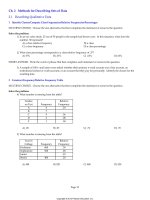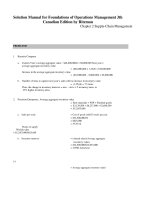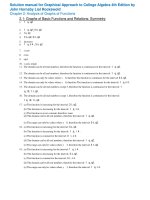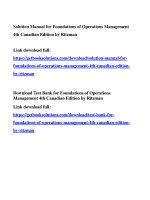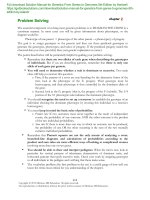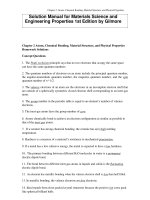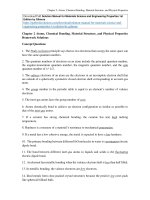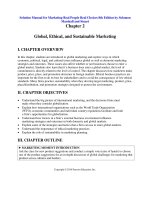Solution manual for a first course in statistics 11th edition by mcclave
Bạn đang xem bản rút gọn của tài liệu. Xem và tải ngay bản đầy đủ của tài liệu tại đây (331.92 KB, 48 trang )
Methods for Describing Sets of Data 5
Chapter
Methods for Describing
Sets of Data
2
2.2
In a bar graph, a bar or rectangle is drawn above each class of the qualitative variable
corresponding to the class frequency or class relative frequency. In a pie chart, each slice of
the pie corresponds to the relative frequency of a class of the qualitative variable.
2.4
First, we find the frequency of the grade A. The sum of the frequencies for all 5 grades must
be 200. Therefore, subtract the sum of the frequencies of the other 4 grades from 200. The
frequency for grade A is:
200 − (36 + 90 + 30 + 28) = 200 − 184 = 16
To find the relative frequency for each grade, divide the frequency by the total sample size,
200. The relative frequency for the grade B is 36/200 = .18. The rest of the relative
frequencies are found in a similar manner and appear in the table:
Grade on Statistics Exam
A: 90−100
B: 80− 89
C: 65− 79
D: 50− 64
F: Below 50
Total
2.6
Frequency
16
36
90
30
28
200
Relative Frequency
.08
.18
.45
.15
.14
1.00
a.
The graph shown is a pie chart.
b.
The qualitative variable described in the graph is opinion on library importance.
c.
The most common opinion is more important, with 46.0% of the responders indicating
that they think libraries have become more important.
Copyright © 2013 Pearson Education, Inc.
From />
6
Chapter 2
d.
Using MINITAB, the Pareto diagram is:
Importance
50
Percent
40
30
20
10
0
More
Same
Importance
Less
Of those who responded to the question, almost half (46%) believe that libraries have
become more important to their community. Only 18% believe that libraries have
become less important.
2.8
a.
Data were collected on 3 questions. For questions 1 and 2, the responses were either
‘yes’ or ‘no’. Since these are not numbers, the data are qualitative. For question 3, the
responses include ‘character counts’, ‘roots of empathy’, ‘teacher designed’, other’, and
‘none’. Since these responses are not numbers, the data are qualitative.
b.
Using MINITAB, bar charts for the 3 questions are:
Chart of Classroom Pets
60
50
Count
40
30
20
10
0
No
Yes
Classroom Pets
Copyright © 2013 Pearson Education, Inc.
From />
Methods for Describing Sets of Data 7
Chart of Pet Visits
40
Count
30
20
10
0
No
Yes
Pet Visits
Chart of Education
30
25
Count
20
15
10
5
0
Character counts
Roots of empathy
Teacher designed
Other
None
Education
2.10
c.
Many different things can be written. Possible answers might be: Most of the classroom
teachers surveyed (61/75 = .813) keep classroom pets. A little less than half of the
surveyed classroom teachers (35/75 = .467) allow visits by pets.
a.
A PIN pad is selected and the manufacturer is determined. Since manufacturer is not a
number, the data collected are qualitative.
Copyright © 2013 Pearson Education, Inc.
From />
8
Chapter 2
b.
Using MINITAB, the frequency bar chart is:
Chart of Manufacturer
120000
100000
Count
80000
60000
40000
ProvencoCadmus
SZZT Electronics
Toshiba TEC
Urmet
Pax Tech.
Glintt
Intelligent
Urmet
Pax Tech.
Omron
KwangWoo
Intelligent
Glintt
Fujuan Landi
CyberNet
0
Bitel
20000
Manufacturer
c.
The Pareto chart for the data is:
Chart of Manufacturer
120000
100000
Count
80000
60000
40000
Toshiba TEC
Bitel
CyberNet
ProvencoCadmus
Omron
KwangWoo
SZZT Electronics
0
Fujuan Landi
20000
Manufacturer
Most of the PIN pads were shipped by Fujian Landi. They shipped almost twice as
many PIN pads as the second highest manufacturer, which was SZZT Electronics. The
three manufacturers with the smallest number of Pin pads shipped were Glintt,
Intelligent, and Urmet.
2.12
a.
The two qualitative variables graphed in the bar charts are the occupational titles of clan
individuals in the continued line and the occupational titles of clan individuals in the
dropout line.
Copyright © 2013 Pearson Education, Inc.
From />
Methods for Describing Sets of Data 9
b.
2.14
In the Continued Line, about 63% were in either the high or the middle grade. Only
about 20% were in the nonofficial category. In the Dropout Line, only about 22% were
in either the high or middle grade while about 64% were in the nonofficial category.
The percents in the low grade and provincial official categories were about the same for
the two lines.
Suppose we construct a relative frequency bar chart for this data. This will allow the
archaeologists to compare the different categories easier. First, we must compute the relative
frequencies for the categories. These are found by dividing the frequencies in each category
by the total 837. For the burnished category, the relative frequency is 133 / 837 = .159. The
rest of the relative frequencies are found in a similar fashion and are listed in the table.
Pot Category
Number Found
Computation
Relative
Frequency
Burnished
133
133 / 837
.159
Monochrome
460
460 / 837
.550
Slipped
55
55 / 837
.066
Curvilinear Decoration
14
14 / 837
.017
Geometric Decoration
165
165 / 837
.197
Naturalistic Decoration
4
4 / 837
.005
Cycladic White clay
4
4 / 837
.005
Cononical cup clay
2
Total
A relative frequency bar chart is:
2 / 837
837
.002
1.001
Chart of Pot Category
.60
Relative Frequency
.48
.36
.24
.12
0
Burnished Monochrome
Slipped
C urv ilinear
Geometric
Naturalistic
Cy cladic
C onical
Pot Category
The most frequently found type of pot was the Monochrome. Of all the pots found,
55% were Monochrome. The next most frequently found type of pot was the Painted in
Geometric Decoration. Of all the pots found, 19.7% were of this type. Very few pots of
the types Painted in naturalistic decoration, Cycladic white clay, and Conical cup clay
were found.
Copyright © 2013 Pearson Education, Inc.
From />
10
2.16
Chapter 2
Using MINITAB, a bar graph is:
Chart of Fieldwork
5000
Count
4000
3000
2000
1000
0
1Interview
2Obs+Partic
3Observ
Fieldwork
4Grounded
Most of the types of papers found were interviews. There were about twice as many
interviews as all other types combined.
2.18
a.
There were 1,470 responses that were missing. In addition, 14 responses were 8 =
Don’t know and 7 responses were 9 = Missing. The missing values were not included,
but those responding with an 8 were kept. Therefore, there were only 1333 useable
responses. The frequency table is:
Response
1
2
3
4
8
Totals
Frequency
450
627
219
23
14
1333
Relative Frequency
450/1333 = .338
627/1333 = .470
219/1333 = .164
23/1333 = .017
14/1333 = .011
1.000
Copyright © 2013 Pearson Education, Inc.
From />
Methods for Describing Sets of Data 11
b. Using MINITAB, the pie chart for the data is:
Pie Chart of Bible Categories
C ategory
1
2
3
4
8
4 8
3
1
2
c.
2.20
The response with the highest frequency is 2, ‘the Bible is the inspired word of God but
not everything is to be taken literally’. Almost 47% of the respondents selected this
answer. About one-third of the respondents answered 1, ‘the Bible is the actual word of
God and is to be taken literally’. Very few (1.7%) of the respondents chose response 4,
‘the Bible has some other origin’ and response 8 (1.1%), ‘Don’t know’.
Using MINITAB a bar chart for the Extinct status versus flight capability is:
C har t of Extinct, Flight
80
70
60
Count
50
40
30
20
10
0
Flight
Extinct
No
Yes
Absent
No
Yes
Present
No
Yes
Extinct
It appears that extinct status is related to flight capability. For birds that do have flight
capability, most of them are present. For those birds that do not have flight capability, most
are extinct.
Copyright © 2013 Pearson Education, Inc.
From />
12
Chapter 2
The bar chart for Extinct status versus Nest Density is:
Char t of Extinct, Nest Density
60
50
Count
40
30
20
10
0
Nest Density
Extinct
H
L
Absent
H
L
Present
H
L
Extinct
It appears that extinct status is not related to nest density. The proportion of birds present,
absent, and extinct appears to be very similar for nest density high and nest density low.
The bar chart for Extinct status versus Habitat is:
C har t of Extinct, H abitat
40
Count
30
20
10
0
Habitat
Extinct
A
TA
TG
Absent
A
TA
TG
Present
A
TA
TG
Extinct
It appears that the extinct status is related to habitat. For those in aerial terrestrial (TA), most
species are present. For those in ground terrestrial (TG), most species are extinct. For those
in aquatic, most species are present.
2.22
The difference between a bar chart and a histogram is that a bar chart is used for qualitative
data and a histogram is used for quantitative data. For a bar chart, the categories of the
qualitative variable usually appear on the horizontal axis. The frequency or relative
frequency for each category usually appears on the vertical axis. For a histogram, values of
the quantitative variable usually appear on the horizontal axis and either frequency or relative
frequency usually appears on the vertical axis. The quantitative data are grouped into
intervals which appear on the horizontal axis. The number of observations appearing in each
interval is then graphed. Bar charts usually leave spaces between the bars while histograms
do not.
Copyright © 2013 Pearson Education, Inc.
From />
Methods for Describing Sets of Data 13
2.24
In a stem-and-leaf display, the stem is the left-most digits of a measurement, while the leaf is
the right-most digit of a measurement.
2.26
As a general rule for data sets containing between 25 and 50 observations, we would use
between 7 and 14 classes. Thus, for 50 observations, we would use around 14 classes.
2.28
Using MINITAB, the relative frequency histogram is:
.25
Relative frequency
.20
.15
.10
.05
0
2.30
2.32
0.5
2.5
4.5
6.5
8.5
10.5
Class Interval
12.5
14.5
16.5
a.
This is a frequency histogram because the number of observations are displayed rather
than the relative frequencies.
b.
There are 14 class intervals used in this histogram.
c.
The total number of measurements in the data set is 49.
a.
Using MINITAB, the dot plot of the honey dosage data is:
Dotplot of Honey Dosage Group
4
b.
6
8
10
ImproveScore
12
14
16
Both 10 and 12 occurred 6 times in the honey dosage group.
Copyright © 2013 Pearson Education, Inc.
From />
14
Chapter 2
c.
2.34
From the graph in part c, 8 of the top 11 scores (72.7%) are from the honey dosage
group. Of the top 30 scores, 18 (60%) are from the honey dosage group. This supports
the conclusions of the researchers that honey may be a preferable treatment for the
cough and sleep difficulty associated with childhood upper respiratory tract infection.
Using MINITAB, the stem-and-leaf display is:
Stem-and-Leaf Display: Depth
Stem-and-leaf of Depth
Leaf Unit = 0.10
2
4
8
(3)
7
5
3
13
14
15
16
17
18
19
N
= 18
29
00
7789
125
08
11
347
The data in the stem-and-leaf display are displayed to 1 decimal place while the actual data is
displayed to 2 decimal places. To 1 decimal place, there are 3 numbers that appear twice –
14.0, 15.7, and 18.1. However, to 2 decimal places, none of these numbers are the same.
Thus, no molar depth occurs more frequently in the data.
2.36
a.
Using MINITAB, the dot plot for the 9 measurements is:
Dotplot of Cesium
-6.0
-5.7
-5.4
-5.1
Cesium
-4.8
-4.5
-4.2
b. Using MINITAB, the stem-and-leaf display is:
Character Stem-and-Leaf Display
Stem-and-leaf of Cesium
Leaf Unit = 0.10
1
2
4
(3)
2
-6
-5
-5
-4
-4
N
= 9
0
5
00
865
11
Copyright © 2013 Pearson Education, Inc.
From />
Methods for Describing Sets of Data 15
c.
Using MINITAB, the histogram is:
H istogr am of C esium
2.0
Frequency
1.5
1.0
0.5
0.0
2.38
-6.0
-5.5
-5.0
Cesium
-4.5
-4.0
d.
The stem-and-leaf display appears to be more informative than the other graphs. Since
there are only 9 observations, the histogram and dot plot have very few observations per
category.
e.
There are 4 observations with radioactivity level of -5.00 or lower. The proportion of
measurements with a radioactivity level of -5.0 or lower is 4 / 9 = .444.
a.
Using MINITAB, the stem-and-leaf display is:
Stem-and-Leaf Display: Spider
Stem-and-leaf of Spider
Leaf Unit = 10
1
3
(3)
4
2
1
0
0
0
0
0
1
N
= 10
0
33
455
67
9
1
b.
The spiders with a contrast value of 70 or higher are in bold type in the stem-and-leaf
display in part a. There are 3 spiders in this group.
c.
The sample proportion of spiders that a bird could detect is 3 / 10 = .3. Thus, we could
infer that a bird could detect a crab-spider sitting on the yellow central part of a daisy
about 30% of the time.
Copyright © 2013 Pearson Education, Inc.
From />
16
2.40
Chapter 2
a.
A stem-and-leaf display of the data using MINITAB is:
Stem-and-leaf of FNE
Leaf Unit = 1.0
2
3
6
10
12
(2)
11
7
3
2
2.42
0
0
1
1
1
1
1
2
2
2
N
= 25
67
8
001
3333
45
66
8999
0011
3
45
b.
The numbers in bold in the stem-and-leaf display represent the bulimic students. Those
numbers tend to be the larger numbers. The larger numbers indicate a greater fear of
negative evaluation. Thus, the bulimic students tend to have a greater fear of negative
evaluation.
c.
A measure of reliability indicates how certain one is that the conclusion drawn is
correct. Without a measure of reliability, anyone could just guess at a conclusion.
a.
Using MINITAB, histograms of the two sets of SAT scores are:
Histogram of SAT2005, SAT2009
960
SAT2005
18
1040
1120
1200
SAT2009
16
Frequency
14
12
10
8
6
4
2
0
960
1040
1120
1200
It appears that the distributions of both sets of scores are somewhat skewed to the right.
However, there appears to be more lower SAT scores for 2009 and more higher SAT
scores for 2009 than 2005.
Copyright © 2013 Pearson Education, Inc.
From />
Methods for Describing Sets of Data 17
b.
Using MINITAB, a histogram of the differences of the 2009 and 2005 SAT scores is:
Histogram of Diff
20
Frequency
15
10
5
0
2.44
2.46
-80
-60
-40
-20
Diff
0
20
40
c.
It appears that there are more differences less than 0 than above 0. Thus, it appears that
in general, the 2009 SAT scores are lower than the 2005 SAT scores.
d.
Wyoming had the largest improvement in SAT scores from 2005 to 2009, with an
increase of 48 points.
a.
∑ x = 5 + 1 + 3 + 2 + 1 = 12
b.
∑x
c.
∑ ( x − 1) = (5 − 1) + (1 − 1) + (3 − 1) + (2 − 1) + (1 − 1) = 7
d.
∑ ( x − 1)
e.
(∑ x)
2
= 52 + 12 + 32 + 22 + 12 = 40
2
2
= (5 − 1)2 + (1 − 1)2 + (3 − 1)2 + (2 − 1)2 + (1 − 1)2 = 21
= (5 + 1 + 3 + 2 + 1) 2 = 12 2 = 144 = (5 + 1 + 3 + 2 + 1)2 = 122 = 144
Using the results from Exercise 2.44,
(∑ x)
−
a.
∑x
b.
∑ ( x − 2)
c.
∑x
2
5
2
2
2
= 40 −
144
= 40 − 28.8 = 11.2
5
= (5 − 2)2 + (1 − 2)2 + (3 − 2)2 + (2 − 2)2 + (1 − 2)2 = 12
− 10 = 40 − 10 = 30
Copyright © 2013 Pearson Education, Inc.
From />
18
Chapter 2
2.48
A measure of central tendency measures the “center” of the distribution while measures of
variability measure how spread out the data are.
2.50
The sample mean is represented by x . The population mean is represented by µ .
2.52
A skewed distribution is a distribution that is not symmetric and not centered around the
mean. One tail of the distribution is longer than the other. If the mean is greater than the
median, then the distribution is skewed to the right. If the mean is less than the median, the
distribution is skewed to the left.
2.54
Assume the data are a sample. The sample mean is:
∑ x = 3.2 + 2.5 + 2.1 + 3.7 + 2.8 + 2.0 = 16.3 = 2.717
x=
n
6
6
The median is the average of the middle two numbers when the data are arranged in order
(since n = 6 is even). The data arranged in order are: 2.0, 2.1, 2.5, 2.8, 3.2, 3.7. The middle
two numbers are 2.5 and 2.8. The median is:
2.5 + 2.8 5.3
=
= 2.65
2
2
2.56
The median is the middle number once the data have been arranged in order. If n is even,
there is not a single middle number. Thus, to compute the median, we take the average of the
middle two numbers. If n is odd, there is a single middle number. The median is this middle
number.
A data set with 5 measurements arranged in order is 1, 3, 5, 6, 8. The median is the middle
number, which is 5.
A data set with 6 measurements arranged in order is 1, 3, 5, 5, 6, 8. The median is the
5 + 5 10
=
= 5.
average of the middle two numbers which is
2
2
2.58
a.
b.
c.
x=
∑ x = 7 + " + 4 = 15 = 2.5
x=
∑ x = 2 + " + 4 = 40 = 3.08
x=
∑ x = 51 + " + 37 = 496 = 49.6
6
6
3+3
= 3 (mean of 3rd and 4th numbers, after ordering)
Median =
2
Mode = 3
n
n
13
13
Median = 3 (7th number, after ordering)
Mode = 3
n
10
10
48 + 50
= 49 (mean of 5th and 6th numbers, after ordering)
Median =
2
Mode = 50
Copyright © 2013 Pearson Education, Inc.
From />
Methods for Describing Sets of Data 19
2.60
2.62
2.64
a.
From the printout, the sample mean is 50.02, the sample median is 51, and the sample
mode is 54. The average age of the 50 most powerful women in business in the U.S. is
50.02 years. The median age is 51. Half of the 50 most powerful women in business in
the U.S. are younger than 51 and half are older. The most common age is 54.
b.
Since the mean is slightly smaller than the median, the data are skewed slightly to the
left.
c.
The modal class is the interval with the largest frequency. From the histogram the
modal class is 50 to 54.
a.
There are 35 observations in the honey dosage group. Thus, the median is the middle
number, once the data have been arranged in order from the smallest to the largest. The
middle number is the 18th observation which is 11.
b.
There are 33 observations in the DM dosage group. Thus, the median is the middle
number, once the data have been arranged in order from the smallest to the largest. The
middle number is the 17th observation which is 9.
c.
There are 37 observations in the control group. Thus, the median is the middle number,
once the data have been arranged in order from the smallest to the largest. The middle
number is the 19th observation which is 7.
d.
Since the median of the honey dosage group is the highest, the median of the DM groups
is the next highest, and the median of the control group is the smallest, we can conclude
that the honey dosage is the most effective, the DM dosage is the next most effective,
and nothing (control) is the least effective.
a.
The mean of the driving performance index values is: x =
∑ x = 77.07 = 1.927
n
40
The median is the average of the middle two numbers once the data have been arranged
in order. After arranging the numbers in order, the 20th and 21st numbers are 1.75 and
1.75 + 1.76
= 1.755
1.76. The median is:
2
The mode is the number that occurs the most frequently and is 1.4.
b.
The average driving performance index is 1.927. The median is 1.755. Half of the
players have driving performance index values less than 1.755 and half have values
greater than 1.755. Three of the players have the same index value of 1.4.
Copyright © 2013 Pearson Education, Inc.
From />
20 Chapter 2
c.
Since the mean is greater than the median, the data are skewed to the right. Using
MINITAB, a histogram of the data is:
Histogram of Performance
10
Fr equency
8
6
4
2
0
2.66
1.5
2.0
2.5
P er for mance
3.0
3.5
a.
The salaries of all persons employed by a large university are probably skewed to the
right. There will be a few individuals with very large salaries (i.e. president, football
coach, Dean of the Medical school). However, the majority of the employees will have
salaries in a rather small range.
b.
The grades on an easy test will probably be skewed to the left. Most students will get
very high grades on the test. Since there is an upper limit to the grades (i.e. 100%),
there will likely be many grades in this upper range. However, even on an easy test, a
few individuals will still not do well.
c.
The grades on a difficult test will probably be skewed to the right. Most students will
get fairly low grades on the test. However, even on a difficult test, a few individuals
will still do quite well.
d.
The amounts of time students in your class studied last week will probably be close to
symmetric. Some individuals will not study very much, while others will study quite a
bit. However, most students will study an average amount of time.
e.
The ages of cars on a used car lot will probably be skewed to the left. Most of the cars
will be fairly new. However, there will probably be a few fairly old cars.
f.
The amounts of time spent by students on a difficult examination will probably be
skewed to the left. If there is a maximum time limit, then most students will take that
amount of time or close to it. There will probably be a few students who take less time
than the maximum allowed.
Copyright © 2013 Pearson Education, Inc.
From />
Methods for Describing Sets of Data 21
2.68
a.
The mean number of ant species discovered is:
x=
∑ x = 3 + 3 + ... + 4 = 141 = 12.82
n
11
11
The median is the middle number once the data have been arranged in order:
3, 3, 4, 4, 4, 5, 5, 5, 7, 49, 52.
The median is 5.
The mode is the value with the highest frequency. Since both 4 and 5 occur 3 times,
both 4 and 5 are modes.
b.
For this case, we would recommend that the median is a better measure of central
tendency than the mean. There are 2 very large numbers compared to the rest. The
mean is greatly affected by these 2 numbers, while the median is not.
c.
The mean total plant cover percentage for the Dry Steppe region is:
x=
∑ x = 40 + 52 + ... + 27 = 202 = 40.4
n
5
5
The median is the middle number once the data have been arranged in order:
27, 40, 40, 43, 52.
The median is 40.
The mode is the value with the highest frequency. Since 40 occurs 2 times, 40 is the
mode.
d.
The mean total plant cover percentage for the Gobi Desert region is:
x=
∑ x = 30 + 16 + ... + 14 = 168 = 28
n
6
6
The median is the mean of the middle 2 numbers once the data have been arranged in
order: 14, 16, 22, 30, 30, 56.
The median is
22 + 30 52
=
= 26 .
2
2
The mode is the value with the highest frequency. Since 30 occurs 2 times, 30 is the
mode.
e.
Yes, the total plant cover percentage distributions appear to be different for the 2
regions. The percentage of plant coverage in the Dry Steppe region is much greater
than that in the Gobi Desert region.
Copyright © 2013 Pearson Education, Inc.
From />
22 Chapter 2
2.70
a.
The mean number of power plants is:
n
∑x
i
x=
i =1
n
=
5 + 2 + 4 + ... + 3 78
=
= 3.9
20
20
The median is the mean of the middle 2 numbers once the data have been arranged in
order: 1, 1, 1, 1, 1, 2, 2, 3, 3, 3, 4, 4, 4, 5, 5, 5, 6, 7, 9, 11
The median is
3+ 4 7
= = 3.5 .
2
2
The number 1 occurs 5 times. The mode is 1.
b. Deleting the largest number, 11, the new mean is:
n
∑x
i
5 + 2 + 4 + ... + 3 67
=
= 3.526
19
19
n
The median is the middle number once the data have been arranged in order:
1, 1, 1, 1, 1, 2, 2, 3, 3, 3, 4, 4, 4, 5, 5, 5, 6, 7, 9
x=
i =1
=
The median is 3.
The number 1 occurs 5 times. The mode is 1.
By dropping the largest measurement from the data set, the mean drops from 3.9 to
3.526. The median drops from 3.5 to 3 and the mode stays the same.
c.
Deleting the lowest 2 and highest 2 measurements leaves the following:
1, 1, 1, 2, 2, 3, 3, 3, 4, 4, 4, 5, 5, 5, 6, 7
The new mean is:
n
∑x
i
x=
i =1
n
=
1 + 1 + 1 + ... + 7 56
=
= 3.5
16
16
The trimmed mean has the advantage that some possible outliers have been eliminated.
2.72
The primary disadvantage of using the range to compare variability of data sets is that the two
data sets can have the same range and be vastly different with respect to data variation. Also,
the range is greatly affected by extreme measures.
2.74
The variance of a data set can never be negative. The variance of a sample is the sum of the
squared deviations from the mean divided by n − 1. The square of any number, positive or
negative, is always positive. Thus, the variance will be positive.
Copyright © 2013 Pearson Education, Inc.
From />
Methods for Describing Sets of Data 23
The variance is usually greater than the standard deviation. However, it is possible for the
variance to be smaller than the standard deviation. If the data are between 0 and 1, the
variance will be smaller than the standard deviation. For example, suppose the data set is
.8, .7, .9, .5, and .3. The sample mean is:
x=
∑ x = .8 + .7 + .9 + .5 + .3 = 3.2 = .64
n
.5
5
The sample variance is:
s2 =
∑
(∑ x)
−
x2
2
n
3.22
5 = 2.28 − 2.048 = .058
5 −1
4
2.28 −
=
n −1
The standard deviation is s = .058 = .241
2.76
a.
b.
c.
2.78
a.
s2 =
s2 =
s2 =
2
202
10 = 4.8889
=
10 − 1
84 −
n
n −1
∑
x
2
(∑ x)
−
2
n
=
n −1
∑
x2
(∑ x)
−
s = 4.8889 = 2.211
1002
40 = 3.3333
40 − 1
380 −
s = 3.3333 = 1.826
2
17 2
20 = .1868
=
20 − 1
18 −
n
n −1
s = .1868 = .432
Range = 4 − 0 = 4
s2 =
b.
∑
x
(∑ x)
−
2
∑
x2
(∑ x)
−
2
82
5 = 2.3
=
4 −1
22 −
n
n −1
s = 2.3 = 1.52
Range = 6 − 0 = 6
s2 =
∑
x2
(∑ x)
−
n
n −1
2
=
17 2
7 = 3.619
7 −1
63 −
s = 3.619 = 1.90
Copyright © 2013 Pearson Education, Inc.
From />
24 Chapter 2
Range = 8 − (−2) = 10
c.
s2 =
(∑ x)
−
2
n
=
n −1
27 2
9 =8
9 −1
s = 8 = 2.828
(−5)2
18 = 1.624
18 − 1
s = 1.624 = 1.274
145 −
Range = 2 − (−3) = 5
d.
s2 =
2.80
∑
x
2
∑x
2
(∑ x)
−
2
n
=
n −1
29 −
This is one possibility for the two data sets.
Data Set 1: 0, 1, 2, 3, 4, 5, 6, 7, 8, 9
Data Set 2: 0, 0, 1, 1, 2, 2, 3, 3, 9, 9
The two sets of data above have the same range = largest measurement − smallest
measurement = 9 − 0 = 9.
The means for the two data sets are:
=
x 0 + 1 + 2 + 3 + 4 + 5 + 6 + 7 + 8 + 9 45
=
=
= 4.5
x1
n
10
10
x 0 + 0 + 1 + 1 + 2 + 2 + 3 + 3 + 9 + 9 30
x2 =
=
=
=3
n
10
10
The dot diagrams for the two data sets are shown below.
∑
∑
Dotplot of Data vs Gr oup
Group
x-bar
1
2
x-bar
0
2
4
6
8
Data
2.82
a.
s2 =
∑
x2
(∑ x)
−
n
n −1
2
=
282
5 = 69.2 = 17.3
5 −1
4
226 −
s = 17.3 = 4.1593
Copyright © 2013 Pearson Education, Inc.
From />
Methods for Describing Sets of Data 25
b.
2.84
x2
(∑ x)
−
x2
(∑ x)
−
∑
2
n
=
n −1
s = 152.25 = 12.339 feet
s2 =
∑
552
4 = 456.75 = 152.25 square feet
4 −1
3
1213 −
2
n
=
(−15)2
6 = 21.5 = 4.3
6 −1
5
59 −
s = 4.3 = 2.0736
c.
s2 =
d.
24 22
−
.2933
n
= 25 6 =
= .0587 square ounces
s2 =
n −1
6 −1
5
s = .0587 = .2422 ounce
a.
For those students who earned A, the range is 53 – 24 = 29.
n −1
∑
x
2
(∑ x)
−
2
The variance is s 2 =
∑x
2
(∑ x)
−
2
n
=
n −1
2962
8 = 530 = 75.7143
7
7
11, 482 −
The standard deviation is s = s 2 = 75.7143 = 8.701 .
b.
For those students who earned a B or C, the range is 40 – 16 = 24.
The variance is s 2 =
∑x
2
(∑ x)
−
n
n −1
2
=
147 2
6 = 363.5 = 72.7
5
5
3,965 −
The standard deviation is s = s 2 = 72.7 = 8.526 .
2.86
c.
The students who received A’s have a more variable distribution of the number of books
read. The range, variance, and standard deviation for this group are greater than the
corresponding values for the B-C group
a.
The range is the difference between the largest and smallest observations and is 17.83 –
4.90 = 12.93 meters.
b.
The variance is:
s2 =
c.
∑
x
2
(∑ x)
−
n
n −1
2
=
126.322
13 = 16.767 square meters
13 − 1
1428.64 −
The standard deviation is s = 16.767 = 4.095 meters.
Copyright © 2013 Pearson Education, Inc.
From />
26 Chapter 2
2.88
a.
The maximum age is 64. The minimum age is 28. The range is 64 – 28 = 36.
b.
The variance is:
s2 =
c.
∑x
2
(∑ x)
−
2
n
=
n −1
25012
50 = 41.530
50 − 1
127135 −
The standard deviation is:
s = s 2 = 41.53 = 6.444
d.
Since the standard deviation of the ages of the 50 most powerful women in Europe is 10
years and is greater than that in the U.S. (6.444 years), the age data for Europe is more
variable.
e.
If the largest age (64) is omitted, then the standard deviation would decrease. The new
variance is:
s2 =
∑x
2
(∑ x)
−
2
n
n −1
=
2437 2
49 = 38.241
49 − 1
123039 −
The new standard deviation is s = s 2 = 38.241 = 6.184 . This is less than the standard
deviation with all the observations (s = 6.444).
2.90
Chebyshev's rule can be applied to any data set. The Empirical Rule applies only to data sets
that are mound-shaped—that are approximately symmetric, with a clustering of
measurements about the midpoint of the distribution and that tail off as one moves away from
the center of the distribution.
2.92
Since no information is given about the data set, we can only use Chebyshev's rule.
2.94
a.
Nothing can be said about the percentage of measurements which will fall between
x − s and x + s .
b.
At least 3/4 or 75% of the measurements will fall between x − 2s and x + 2s .
c.
At least 8/9 or 89% of the measurements will fall between x − 3s and x + 3s .
a.
x=
s2 =
∑ x = 206 = 8.24
n
∑x
25
2
(∑ x)
−
n
n −1
2
=
2062
25 = 3.357
25 − 1
1778 −
s = s 2 = 1.83
Copyright © 2013 Pearson Education, Inc.
From />
Methods for Describing Sets of Data 27
b.
Number of Measurements
in Interval
Interval
Percentage
x ± s , or (6.41, 10.07)
18
18/25 = .72 or 72%
x ± 2s , or (4.58, 11.90)
24
24/25 = .96 or 96%
x ± 3s , or (2.75, 13.73)
25
25/25 = 1
or 100%
c.
The percentages in part b are in agreement with Chebyshev's rule and agree fairly well
with the percentages given by the Empirical Rule.
d.
Range = 12 − 5 = 7
s ≈ range/4 = 7/4 = 1.75
The range approximation provides a satisfactory estimate of s.
2.96
From Exercise 2.60, the sample mean is x = 50.02 . From Exercise 2.88, the sample standard
deviation is s = 6.444. From Chebyshev’s Rule, at least 75% of the ages will fall within 2
standard deviations of the mean. This interval will be:
x ± 2 s ⇒ 50.02 ± 2(6.444) ⇒ 50.02 ± 12.888 ⇒ (37.132, 62.908)
2.98
a. If the data are symmetric and mound shaped, then the Empirical Rule will describe the
data. About 95% of the observations will fall within 2 standard deviation of the mean.
The interval two standard deviations below and above the mean is
x ± 2 s ⇒ 39 ± 2(6) ⇒ 39 ± 12 ⇒ (27, 51) . This range would be 27 to 51.
b. To find the number of standard deviations above the mean a score of 51 would be, we
subtract the mean from 51 and divide by the standard deviation. Thus, a score of 51 is
51 − 39
= 2 standard deviations above the mean. From the Empirical Rule, about .025 of
6
the drug dealers will have WR scores above 51.
c. By the Empirical Rule, about 99.7% of the observations will fall within 3 standard
deviations of the mean. Thus, nearly all the scores will fall within 3 standard deviations
of the mean. The interval three standard deviations below and above the mean is
x ± 3s ⇒ 39 ± 3(6) ⇒ 39 ± 18 ⇒ (21, 57) . This range would be 21 to 57.
2.100
a.
x ± 2 s ⇒ 13.2 ± 2(19.5) ⇒ 13.2 ± 39 ⇒ (−25.8, 52.2) . Since time cannot be negative, the
interval will be (0, 52.2) .
b. The number of minutes a student uses a laptop for taking notes each day must be a
positive number. The standard deviation is larger than the mean. Thus, even one
standard deviation below the mean is a negative number. This implies that the
distribution cannot be symmetric.
Copyright © 2013 Pearson Education, Inc.
From />
28 Chapter 2
2.102
c.
Since we know the distribution of usage times cannot be symmetric, we can use
Chebyshev’s Rule. We know that at least ¾ or 75% of the observations will be within
2 standard deviations of the mean. Thus, we know that at least 75% of the students have
laptop usages between -25.8 and 52.2 minutes per day. Since we know we cannot have
negative usages, the interval will be from 0 to 52.2 minutes.
a.
There are 2 observations with missing values for egg length, so there are only 130
useable observations.
x=
s2 =
∑ x 7,885
=
= 60.65
130
n
∑x
2
(∑ x)
−
n
n −1
2
=
(7,885) 2
130 = 249,586.4231 = 1,934.7785
130 − 1
129
727,842 −
s = s 2 = 1,934.7785 = 43.99
b.
The data are not symmetrical or mound-shaped. Thus, we will use Chebyshev’s Rule.
We know that there are at least 8/9 or 88.9% of the observations within 3 standard
deviations of the mean. Thus, at least 88.9% of the observations will fall in the interval:
x ± 3s ⇒ 60.65 ± 3(43.99) ⇒ 60.65 ± 131.97 ⇒ (−71.32, 192.69)
Since it is impossible to have negative egg lengths, at least 88.9% of the egg lengths
will be between 0 and 192.69.
2.104 If we assume that the distributions are symmetric and mound-shaped, then the Empirical Rule
will describe the data. We will compute the mean plus or minus one, two and three standard
deviations for both data sets:
Low income:
x ± s ⇒ 7.62 ± 8.91 ⇒ (−1.29, 16.53)
x ± 2s ⇒ 7.62 ± 2(8.91) ⇒ 7.62 ± 17.82 ⇒ (−10.20, 25.44)
x ± 3s ⇒ 7.62 ± 3(8.91) ⇒ 7.62 ± 26.73 ⇒ (−19.11, 34.35)
Middle Income:
x ± s ⇒ 15.55 ± 12.24 ⇒ (3.31, 27.79)
x ± 2s ⇒ 15.55 ± 2(12.24) ⇒ 15.55 ± 24.48 ⇒ (−8.93, 40.03)
x ± 3s ⇒ 15.55 ± 3(12.24) ⇒ 15.55 ± 36.72 ⇒ (−21.17, 52.27)
Copyright © 2013 Pearson Education, Inc.
From />
Methods for Describing Sets of Data 29
The histogram for the low income group is as follows:
Relatie frequency
.35
.30
.25
.20
.15
.10
.05
-19.11
-10.00
-1.29
7.62
Complexity
16.53
25.44
34.35
The histogram for the middle income group is as follows:
Relatie frequency
.35
.30
.25
.20
.15
.10
.05
-21.17
-8.93
3.31
15.55
Complexity
27.79
40.03
52.27
The spread of the data for the middle income group is much larger than that of the low
income group. The middle of the distribution for the middle income group is 15.55, while the
middle of the distribution for the low income group is 7.62. Thus, the middle of the
distribution for the middle income group is shifted to the right of that for the low income
group.
We might be able to compare the means for the two groups. From the data provided, it looks
like the mean score for the middle income group is greater than the mean score for the lower
income group.
(Note: From looking at the data, it is rather evident that the distributions are not moundshaped and symmetric. For the low income group, the standard deviation is larger than the
mean. Since the smallest measurement allowed is 0, this indicates that the data set is not
symmetric but skewed to the right. A similar argument could be used to indicate that the data
set of middle income scores is also skewed to the right.)
Copyright © 2013 Pearson Education, Inc.
From />
